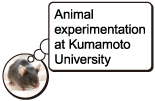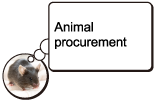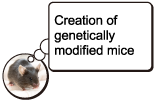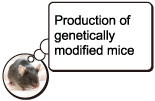Mice health management
At the Animal Facility, animal care managed monitor mice are used to monitor the health of all mice at mice rooms.
Care and examination of monitor mice
By inspecting and caring for the monitor mice using the method below, the health of all mice in the animal care rooms can be monitored.- The air flow of animal care rooms is controlled and designed so that air flows into monitor cages after passing through other cages.
- When cages are changes during animal care management, a small amount of feces from animal care cages in the mice rooms is added to monitor mice cages.
- Monitor mice raised for more than 10 weeks are then examined.
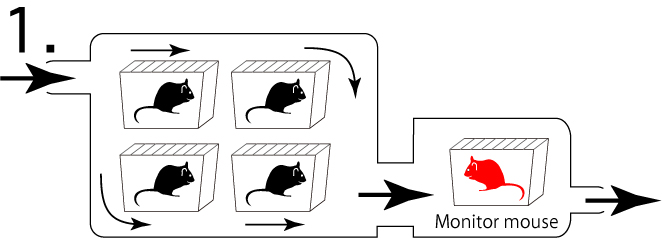
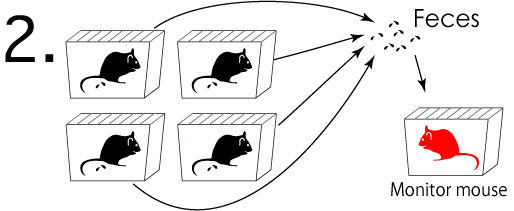

Mice examination items
Pathogenic microorganisms that have been identified with respect to monitor mice are shown below. (2015/10/02)
| Examination items | examination method | Mice |
Rats |
| Ectromelia virus |
ELISA/IFA | ○ |
− |
| Lymphocytic Choriomeningitis Virus |
ELISA/IFA | ○ |
− |
| Mouse adenovirus |
ELISA/IFA | ○ |
○ |
| Mouse hepatitis virus |
ELISA/IFA | ○ |
− |
| Pneumonia virus of mice |
ELISA/IFA | ○ |
○ |
| Sendai virus |
ELISA/IFA | ○ |
○ |
| Sialodacryoadenitis virus |
ELISA/IFA | − |
○ |
| CAR bacillus |
ELISA/IFA | ○ |
○ |
| Citrobacter rodentium |
culture; DHL agar culture medium (caecal content) |
○ |
− |
| Clostridium piliforme |
ELISA/IFA | ○ |
○ |
| Corynebacterium kutscheri |
culture; FNC culture medium (trachea, laryngopharynx, caecal content) |
○ |
○ |
| Helicobacter hepaticus |
CR (feces) | ○ |
− |
| Mycoplasma pulmonis |
ELISA/IFA/ culture; PPLO broth broth (trachea, laryngopharynx) |
○ |
○ |
| Salmonella typhimurium |
culture; DHL agar medium (caecal content) |
○ |
○ |
| ★Pseudomonas aeruginosa |
culture; NAC agar medium (caecal content) |
○ |
○ |
| ★Pasteurella pneumotropica |
culture; blood sample agar medium (trachea/laryngopharynx) |
○ |
○ |
| ★Staphylococcus aureus |
culture; mannitol with vitellus, Salt culture medium(caecal content) |
○ |
○ |
| Aspiculuris tetraptera |
naked-eye observation of imago (proximal portion of colon) |
○ |
− |
| Syphacia obvelata |
microscopic examination; observation of eggs using cellophane tape method (perianal region) | ○ |
− |
| Syphacia muris |
microscopic examination; observation of eggs using cellophane tape method (perianal region) | − |
○ |
| Giardia muris |
microscopic examination; direct smear sample (duodenal content) | ○ |
○ |
| Spironucleus muris |
microscopic examination; direct smear sample (duodenal content) | ○ |
○ |
| Trichomonas spp. |
microscopic examination; direct smear sample (caecal content) | ○ |
○ |
| Ectoparasite |
microscopic examination; observation of imago using cellophane tape method, observation of eggs (fur) | ○ |
○ |
★: immunodeficient animals only
NEWS
- New web site is opened.
2016.03.31
SUPPORT
ACTIVITIES
STAFF
Kumamoto University
Institute of Resource Development and Analysis
Center for Animal Resources and Development
〒860-0811
2-2-1 Honjo, Chuo-ku, Kumamoto-shi
TEL :096-373-6550
FAX :096-373-6552
Email :mimura(a)kumamoto-u.ac.jp
Liaison:Imura
Contact List (Internal University use only)
Institute of Resource Development and Analysis
Center for Animal Resources and Development
〒860-0811
2-2-1 Honjo, Chuo-ku, Kumamoto-shi
TEL :096-373-6550
FAX :096-373-6552
Email :mimura(a)kumamoto-u.ac.jp
Liaison:Imura
Contact List (Internal University use only)

